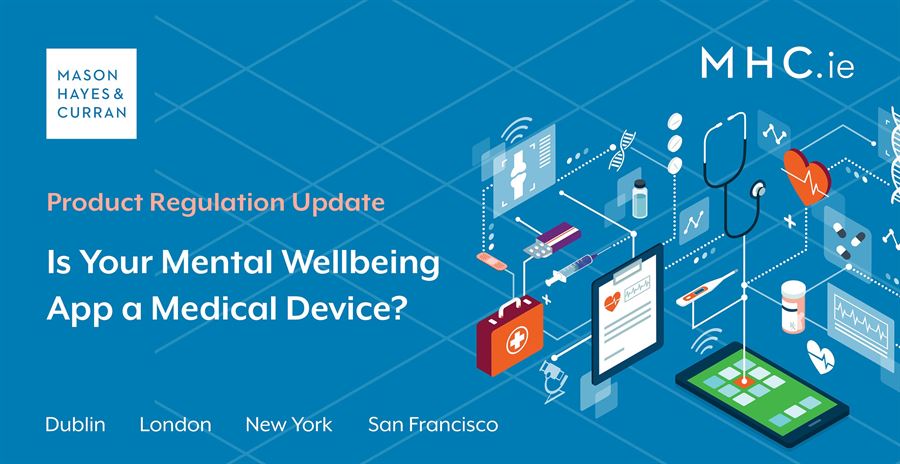
Although awareness around mental health was already improving and the potential for digital health technologies to provide uniquely effective solutions in this space was already recognised, the COVID-19 pandemic has only increased interest in digital means of monitoring and managing our psychological wellbeing. For developers of these types of apps however, the line that exists between an app addressed to general emotional wellbeing and a software medical device falling within the framework provided for under the Medical Device Regulation (EU) 2017/745 (MDR) can sometimes be difficult to define and navigate. We take a look at some important factors to be mindful of.
Why is this important?
If an app is a medical device it must comply with the requirements under the MDR in order to be permitted to be placed on the EU market. These requirements are based on a risk assessment of devices according to classification rules provided for under the MDR (from low to high: Class I, Class IIa, Class IIb and Class III). Certain types of Class I devices and devices that are class IIa or higher require third-party conformity assessment by a notified body who will assess and certify an app as compliant with the requirements under the MDR before it can be placed on the market. The MDR also makes specific provision for software medical devices in its classification rules with the result that the majority of apps that are medical devices will require this third-party conformity assessment.
Placing an app on the EU market that is later found to be an unregulated software medical device can result in regulatory enforcement action, including enforced recall of the app from the market, and attending negative publicity and reputational damage. Depending on the work required by the developer to demonstrate compliance, the process of having the app deemed compliant with the MDR and placing it back on the market can then require at least 9-12 months according to current waiting times for conformity assessment services by notified bodies.
What to do
The obligation to correctly assess what type of app is being developed, and whether or not it is subject to the requirements set out under the MDR, rests with the developer. This requires a detailed and careful analysis that needs to be carried out on a case-by-case basis. However, there are some key points to be aware of:
Intended purpose
The intended purpose of the app in question is particularly relevant in assessing whether or not it amounts to a medical device. Developers therefore need to be able to clearly state what the intended purpose of the app is while having regard to the definition of a medical device provided for under the MDR. Whereas more general emotional wellbeing apps aimed at supporting a mindfulness practice, stress management techniques or improved sleep hygiene may not trigger obligations under the MDR, apps that could be considered to go further than this by seeking to address mental illnesses need to be treated with care from a regulatory standpoint.
Definition of medical device
Article 2 of the MDR provides a sophisticated definition of “medical device” that needs to be carefully analysed in order to assess whether or not the app in question is captured. Of note, this definition refers to software that are intended by their manufacturer to be used for a variety of “specific medical purposes” which need to be reviewed with reference to the claims and functions of the app in question. In the context of mental health and wellbeing, particular consideration may need to be given to whether or not the app is intended to diagnose, prevent, monitor, predict, treat or alleviate a recognised psychiatric illness or condition.
Claims and promotional material
Apart from the stated intended purpose, the way that an app is actually then presented to potential users also has a bearing on qualification as a medical device. Developers therefore need to be careful to ensure that claims made in relation to their apps (and the overall content of marketing and promotional material) do not create an impression that the software is intended to be used for one of the specific medical purposes provided for in the definition of a medical device. This can be particularly important in the context of emotional and mental wellbeing apps, given the fine distinction that can exist between functions that support or encourage healthy behaviours on one hand, and functions addressed to actual psychiatric illnesses or conditions on the other.
Guidance
Various guidance documents relating to the qualification and classification of medical devices should also be consulted. For example, guidance published by the Medical Device Coordination Group (MDCG) clarifies that apps involved in the monitoring of mental health conditions such as depression can be classed as medical devices.
Conclusion
The legislation and guidance governing the regulation of software medical devices is complex, and apps need to be assessed individually by developers to assess whether or not the medical device framework is triggered in any give case. Ideally, that assessment should take place in the very early stages of the software development process, and indeed, the first step towards an effective and well-reasoned assessment involves developing an awareness of the risk of an app relating to mental health or wellbeing being deemed to be a software medical device in the first place. Beyond that, developers can then adopt a structured and strategic approach, ideally drawing on the necessary legal and technical expertise, in order to ensure that the app they intend to make available to users is compliant with all necessary regulatory requirements.
For more information, please contact a member of our Product Regulation & Consumer Law team.
The content of this article is provided for information purposes only and does not constitute legal or other advice.
Share this:







